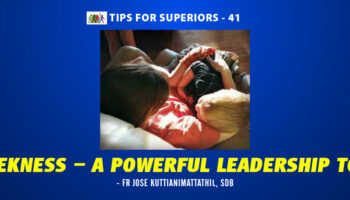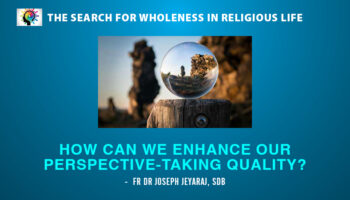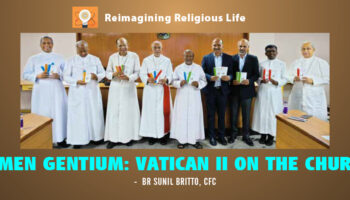16 JANUARY
FR ROBERTO DE NOBILI SJ (1577-1656)
He came from a noble family in Rome. Joined the Jesuits (against his family’s strong opposition). Came to India as a missionary. Noticed that the Portuguese missionaries had a very poor understanding of local cultures and languages, expected the Indian converts to give up their customs, and adopt European ways.
De Nobili studied Tamil and became very adept in that language. Learnt to read Sanskrit texts. Mixing with educated Hindus and reading Indian religious literature, he realized that upper caste Hindu looked down upon the Portuguese (for eating meat, drinking and not bathing regularly) and despised the local converts. He decided to enter into that world rather than remain an outsider. Adopted the saffron robe of a sanyasi, wore wooden sandals instead of shoes, spoke in Tamil and ate vegetarian food.
Upper caste Hindus started listening to this learned foreigner who could read, speak and write their languages, and had adapted their ways. He not only dressed and ate like a Hindu sanyasi, but he demonstrated a deep, scholarly understanding of Hindu religious texts, and presented Jesus as a guru. A number of Brahmins and others who had earlier shunned the Christians joined the church. Several influential people within the Church, however, were shocked at his “strange” new ways, and thought it a foolish aberration They influenced Rome to stop this “crazy” experiment. A local synod condemned him, but a decision from Rome later exonerated him.
————————————————————————————————————————————————-
23 JANUARY
MARY WARD (1586-1645)
Many founders and other pioneers faced opposition, misunderstanding and official disapproval, but Mary Ward’s case was particularly hard and unfair.
Her story in brief:
She was born into an aristocratic family in England at a time when Catholics were persecuted, priests travelled in secret and there were no convents. Her family wanted the good-looking and smart Mary to get married, but she wanted to become a nun. With no such chance in England, she went to Belgium, and joined the Poor Clares, who took her as a lay sister (meant to do manual work).
Left the order, with the dream of not only being a nun, but of starting an order of nuns who could work outside a traditional monastery—to do as women what the Jesuits were doing as male religious. This sounded like heresy in those days, and she faced fierce opposition, both from the church authorities and from society, which did not see women as equal to men. She suffered much for her convictions and her fidelity—contempt of influential people, imprisonment, and seeing the order suppressed. She later faced the further humiliation of having the order restored, provided she was not mentioned as the foundress.
As it happened with other heroic figures, the same church that gave her such a hard time in her life time later changed its perception of her, admitted her heroic holiness and declared her venerable.
She is the foundress of two congregations of women—the Loreto Sisters and Congregation of Jesus.
May what we understand as fidelity not only make us preserve what is old and valid, but also be open to the new ways in which God speaks to us.
————————————————————————————————————————————————-
24 JANUARY
ST FRANCIS DE SALES (1567-1622)
His is the inspiring story of an unusual bishop who could never enter the city of which he was bishop, but wielded tremendous influence. One of his books became what we today would call a bestseller.
In a time of bitter antagonism among Christian churches, Francis de Sales decided to tread the path of gentleness.
Coming from a wealthy family that wanted him to become a lawyer and work in government service, he studied law, but chose to be a priest. He volunteered to work in Geneva, then a Calvinist stronghold that would not tolerate any Catholic presence. There were attempts on his life. He lived in poverty, relying on alms.
When he was appointed bishop of Geneva, the authorities would not allow him to enter the city. He administered the diocese from Annecy. He used love and gentleness to win over the people. More than two thousand families re-joined the church.
Bishop Francis became a famous preacher and a sought-after spiritual director. His book, An Introduction to the Devout Life, became widely popular. It presented holiness as something meant for everyone, not just for monks and nuns. He explained the way to God in simple, earthy examples which anyone would follow. Here are of three of his best-known sayings:
In a time of moral rigidity and religious wars, he said, “We can catch more flies with a spoonful of honey than with a barrel of vinegar.”
When preachers thundered on God’s punishments and on the need for physical penance, his stand was: “I would rather be judged by God than by my own mother.”
In the midst of bitter antagonism from other denominations, he once told an opponent, “Even if you pluck out one of my eyes, I will look at you kindly with the other eye.”
What an example!
————————————————————————————————————————————————-
28 JANUARY
THOMAS AQUINAS (1125-1274)
He came from a noble family in Southern Italy, which kept him with the Benedictine monks of Monte Cassino for studies. That monastery was influential, and his family would have liked it if Thomas had joined this politically powerful group. Instead, they shocked him by wanting to join a new group of “begging (mendicant) friars,” the Dominicans. To make him give up his idea, they locked up in their castle for a year, but finally relented.
Quiet and corpulent, Thomas was at first ridiculed by his fellow pupils at the university as a “Dumb Ox.” But his professor, the erudite Albert the Great, saw his pupil’s acumen and predicted, “One day this Dumb Ox’s bellowing will be heard all over the world.”
Thomas Aquinas was an exceptional genius who could dictate to four secretaries simultaneously on different topics, wrote on a vast number of topics and impressed his contemporaries for both his towering intellect and his holiness of life.
He was open to the secular learning available at the university, namely, the vast corpus of Aristotle’s writings. Some church people were scandalized that Thomas used the philosophy of this non-Christian thinker as a tool for his theology. His writings were condemned twice by the bishop of Paris. Later, he would become the best known and most quoted Christian theologian of all time.
Several doctrines that form the bedrock of Catholic theology go back to the approach Thomas Aquinas took: A positive view of human nature, trust in reason, the autonomy of the human sciences, the healthy role of passions in life (they are to be tamed, not despised or discarded), the importance of friendship, the central role of creativity in ethics (since we are the image of the Creator), personal responsibility in moral judgements, the right everyone has to enjoy the goods of the earth, the focus on the learner in education, and a humble recognition of our ignorance of God (“This is to know God, that we are aware that we do not know God”) which saves us from arrogant claims or narrow rejection of others’ religious views.
Aquinas’ reputation has been damaged by a number of mediocre “Thomists,” who quoted him without understanding him, and tended to impose “Thomism” as an answer to all questions, which is in sharp contract to his own spirit of inquiry, openness and awareness of limit.
That, unfortunately, happens to many first rate minds who become victims of their third rate followers!

To subscribe to the magazine Contact Us





